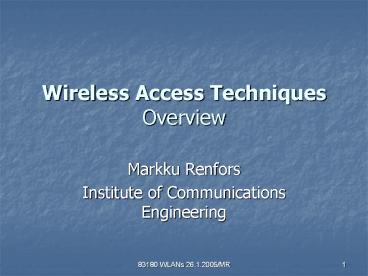Wireless Access Techniques Overview - PowerPoint PPT Presentation
1 / 16
Title:
Wireless Access Techniques Overview
Description:
Homes (e.g., ADSL modem acting as the access point) ... Competes with ADSL and cable modems, but is able to offer higher data rates ... – PowerPoint PPT presentation
Number of Views:93
Avg rating:3.0/5.0
Title: Wireless Access Techniques Overview
1
Wireless Access Techniques Overview
- Markku Renfors
- Institute of Communications Engineering
2
Wireless Access Techniques
- WLAN, Wireless Local Area Network
- IEEE 802.11, ETSI Hiperlan
- WPAN, Wireless Personal Area Network
- IEEE 802.15, Bluetooth, Home RF, UWB
- BWA, (Fixed) Broadband Wireless Access
- WMAN, Wireless Metropolitan Area Network
- IEEE 802.16, ETSI HiperAccess
3
Common Characteristics
- High data rate, in most cases gt 1 Mb/s
- Low mobility stationary or pedestrian
- Local coverage
- Physical MAC layers and security mechanisms
specified by wireless standards, higher layers
based on common Internet protocols - Unlicenced Industrial, Scientific, and Medical
(ISM) bands mostly used - OFDM modulation techniques are in an important
role in recent physical layer developments
4
WLAN Characteristics
- 1... 54 Mb/s data rates (currently)
- Intended for short distances, one base-station
covering, e.g., - A few rooms/1 corridoor in office building
- A small house
- A few hundred meters distances in open air,
somewhat longer with directive antennas - Power consumption usually not very critical
5
WLAN Elements
- Extends Ethernet over wireless
- Two modes
- Infrastructure WLAN Terminals communicate with
Radio Access Point (base-stations), which acts
as a bridge to the fixed Internet - Ad-Hoc Network Terminals communicate with each
other, without centralized control - Each wireless station and access point has a
wireless LAN card Integrated solutions
currently, e.g., in Laptops, ADSL Modems,
PDAs/Communicators
6
WLAN Applications
- Cable-free access to internet in
- Office environments
- Homes (e.g., ADSL modem acting as the access
point) - Hot-spots, like airports, conference centers,
etc. - Also used as high-speed access method for homes
and small offices in urban areas, instead of ADSL
or cable modems.
7
WLAN Application Aspects
- Designed for data communications
- Problems with latency and Quality of Service in
case of real-time audiovisual services - Limitations in data security mechanisms
8
WLAN Standards
- Regulatory bodies specify the frequency bands
and transmission power levels for different
signal formats - FCC in USA
- CEPT/ETSI in Europe
- ARIB in Japan
- System standards by
- IEEE (802.11) gt ISO/IEC
- ETSI (Hiperlan)
9
Transmission Power Levels
- 2400-2483.5 MHz (most commonly used band)
- USA 1 W
- Europe 100 mW EIRP or 10 mW/MHz (some variations
in different countries) - 5150-5350 MHz
- Europe 200 mW EIRP, only indoor use
- 5470-5725 MHz
- Europe 1 W EIRP, indoor and outdoor use
- Certain mechanisms (dynamic frequency selection,
DFS, transmit power control, TPC) are imposed to
limit interferences to other services. - EIRP Effective radiated power level relative to
isotropic
10
802.11
- 802.11a OFDM-based physical layer for 5 GHz,
6-54 Mb/s - 802.11b DSSS-based physical layer for 2.4 GHz,
5.5 and 11 Mb/s - 802.11c Supplement to support MAC bridge
operation - 802.11d Specification for operation in
different regulatory domains - 802.11e MAC enhancements for QoS (active)
- 802.11F Interaccess point protocol
- 802.11g OFDM-based (also other optional modes)
physical layer for - 2.4 GHz, -54 Mb/s
- 802.11h Spectrum and power management
enhancements to 802.11a - 802.11i Security enhancements (active)
- 802.11j Enhancement of 802.11a for 4.9-5.0 GHz
in Japan (active) - 802.11k Radio resource management (active)
- 802.11m Technical corrections and clarifications
(active) - 802.11n High-thoughput enhancements (active)
11
Indoor Channel Models
- Average attenuation of some building materials
at 2.4 GHz - Window 3 dB
- Floor/ceiling 12-15 dB
- Wall (wood) 10 dB
- Wall (metal and concrete) 15-20 dB
- Typical rms delay spread in some environments
- Home 50 ns
- Office 100-150 ns
- Large indoor spaces 250 ns
- Pedestrian speed (5 mph) leads to 37 Hz maximum
Doppler at 5 GHz, i.e., coherence time in the
order of 25 ms - 10-15 dB fades observed when people are walking
around the wireless station. - Antenna diversity (e.g., MIMO) help to improve
capacity
12
WPAN, Wireless Personal Area Network
- Cable replacement
- Short distances, up to 10 m
- Bluetooth, HomeRF 0.7-2 Mb/s data rates
- Wireless earphones, hands-free sets
- Mobile phone laptop/PC synchronization
- Low power, low cost
- High-rate WPAN, UWB systems
- Digital image/video down-load/exchange
- Low-rate WPAN, RF-ID
- Sensors, meter-reading, smart tags/badges, home
automation - Ultra low power and cost need short range
13
802.15 WPAN
- 802.15.1 WPAN based on Bluetooth v.1.1
- 802.15.1a WPAN based on Bluetooth v.1.2
- 802.15.2 Coexistence of WPAN with other
- systems at 2.4 GHz
- 802.15.3 High-rate WPAN
- 802.15.3a Additional UWB physical layer
- 802.15.4 Low-rate WPAN
- 802.15.4a Additional physical layer
14
WMAN, Wireless Personal Area NetworkBWA, Fixed
Broadband Wireless Access Systems
- Broadband Internet connections to homes and
small offices - Competes with ADSL and cable modems, but is able
to offer higher data rates
15
802.16 BWA
- 802.16 Fixed BWA systems between 10 and 66 MHz
- 802.16a Amendment for operation between 2 and 11
GHz - 802.16c Enhancements including system profiles,
- 10-66 GHz
- 802.16.2 Coexistence between 2 and 11 GHz
- 802.16/Conf Test and conformance specifications
(active) - 802.16d System profiles (active)
- 802.16e Enhancement to support mobility (active)
16
References
- T. Cooklev, Wireless Communications Standards, A
Study of 802.11, 802.15, and 802.16, IEEE Press,
2004 - 2,45 GHz WLAN regulations in Finland
- http//www.ficora.fi/englanti/radio/2_45GHz.htm
- 5 GHz WLAN regulations in Finland
- http//www.ficora.fi/englanti/radio/RLANnotice.htm































